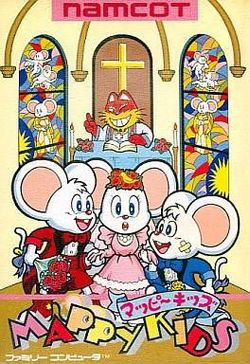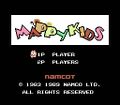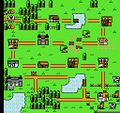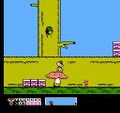
| Mappy Kids | |
|---|---|
| Developer(s) | Namco |
| Publisher(s) | Namco |
| Year released | |
| System(s) | Famicom |
| Preceded by | Mappy-Land |
| Followed by | Mappy Arrangement |
| Series | Mappy |
| Japanese title | マッピーキッズ |
|---|---|
| Genre(s) | Platform |
| Modes | Single player, Multiplayer |
Mappy Kids (マッピーキッズ, lit. Mappī Kizzu), is a platform game that was released by Namco for the Famicom on December 22, 1989 (only in Japan); it is the fourth title in the Mappy series, and the only one which did not see a release for the United States. The player(s) must take control of Mappy's two sons Happy (who wears a red hat and bandanna) and Rappy (who wears a blue hat and bandanna), who both want to find a wife, but neither of them can marry until they have become providers for their families - and, in order to do that, they have to accumulate as much Yen as they can over a selection of fifteen out of sixteen (five out of nine for the two-player mode) stages then fight to keep it in one of three Nyamco-refereed minigames against a Mewky (for the two-player mode, Mappy's sons have to compete against each other instead of a Mewky, and the "Flags" game is also impossible for players who cannot read Japanese). If either player loses a minigame, they will also lose 20000 Yen; both of Mappy's sons use their money to buy parts (for building a house with), but if they later spin a skull on the virtual slot machine before the next minigame then they shall lose one of their accumulated parts and have to spin again (however, if they spin a Super Mario Bros.-style question box, they may earn another part for winning the minigame, or a considerable amount of Yen that they can buy one with).
In 2013, an English translation of the game was released by Zynk Oxhyde; in addition to changing the game's font, they also changed some of the character sprites (including the elephant in the shop, who now has a longer trunk), and made the "Flags" game possible for players who cannot read Japanese.
-
The game's title screen.
-
1P mode overworld map.
-
Screenshot of the game.


